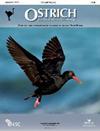角鹦鹉粗壮的饮食在果壳:使用本土和外来植物在东开普省,南非
IF 1.3
4区 生物学
Q2 ORNITHOLOGY
引用次数: 2
摘要
了解濒危物种的饲养和繁殖要求可以提高其保护行动的成功率。Cape Parrot Poischalus robustus是一种受威胁的地方病,仅限于南非的雾带森林。Cape Parrots被认为是饮食专家,更喜欢黄杨/非洲杨的果核,并在没有这些果核的情况下食用其他物种。从2016年到2021年,我们通过有针对性和机会性的观察,调查了东开普省阿马特霍尔地区开普鹦鹉的饮食组成。我们监测了这段时间内本土和外来森林水果的供应情况,并确定季节间和季节内的差异是否显著。我们还每周在山核桃果园监测鹦鹉角的存在和饮食,并收集山核桃坚果进行成分分析。此外,我们还调查了Cape Parrots是否追踪了这种外来的觅食资源,以及当地土著水果的丰度和山核桃坚果成分的变化。在这项研究中,观察到开普鹦鹉以36种树木为食,其中61%是外来物种。我们记录了24种新的树种(大部分是外来物种),以前没有记录到被这种鹦鹉吃掉。然而,大多数喂食记录都是鹦鹉吃本土物种而不是外来物种,不包括它们在山核桃园进食的有针对性的观察。尽管当地森林水果的供应量相对较高,但开普鹦鹉在每个季节都以山核桃为食。虽然不显著,但Cape Parrots似乎在每个季节都会跟踪山核桃坚果成分的变化,当山核桃的脂肪水平最高时,数量最多。根据每年对外来山核桃园的观察和它们饮食中大量外来物种的观察,开普鹦鹉似乎正在适应人类改造的栖息地。外来喂养资源对它们健康的影响还有待确定。本文章由计算机程序翻译,如有差异,请以英文原文为准。
Cape Parrot Poicephalus robustus diet in a nutshell: use of indigenous and exotic plants in the Eastern Cape province, South Africa
The success of conservation action for a threatened species can be improved by knowledge of its feeding and breeding requirements. The Cape Parrot Poicephalus robustus is a threatened endemic restricted to patches of mistbelt forest in South Africa. Cape Parrots are considered dietary specialists, preferring the kernels of yellowwood Podocarpus/Afrocarpus species, and consuming other species when these are not available. We investigated the diet composition of Cape Parrots in the Amathole region of the Eastern Cape province through targeted and opportunistic observations from 2016 to 2021. We monitored the availability of indigenous and exotic forest fruit over this timeframe and determined whether between-season and within-season differences were significant. We also monitored Cape Parrot presence and diet, weekly, at a pecan tree orchard and collected pecan nuts for compositional analysis. Additionally, we investigated whether Cape Parrots tracked this exotic feeding resource relative to local indigenous fruit abundance and changes in pecan nut composition. Cape Parrots were observed feeding on 36 tree species during this study, of which 61% were exotic. We recorded 24 new tree species (mostly exotics) not previously recorded as eaten by this parrot species. However, most feeding records were of parrots eating indigenous rather than exotic species, excluding the targeted observations of them eating at pecan orchards. Cape Parrots fed on pecans in each season despite the relatively high availability of indigenous forest fruits. Although not significant, Cape Parrots appeared to track changes in pecan nut composition during each season, gathering in the largest numbers when fat levels in the pecans were highest. Cape Parrots appear to be adapting to human-modified habitat based on the observations of annual visits to exotic pecan orchards and the high number of exotic species in their diet. The impact of exotic feeding resources on their health remains to be determined.
求助全文
通过发布文献求助,成功后即可免费获取论文全文。
去求助
来源期刊

Ostrich
生物-鸟类学
CiteScore
2.10
自引率
30.00%
发文量
24
审稿时长
>12 weeks
期刊介绍:
Ostrich: Journal of African Ornithology is the leading ornithological journal in Africa, and publishes peer-reviewed scientific papers and short communications (
 求助内容:
求助内容: 应助结果提醒方式:
应助结果提醒方式:


